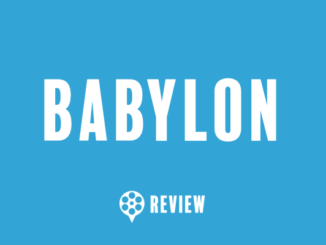On June 4, 2004, I decided to give the Harry Potter franchise one more shot. Since I’ve never read one of the books, my only exposure to J.K. Rowling’s world has been through the films. Harry Potter and the Sorcerer’s Stone had some whimsical moments but I was left underwhelmed by the sluggish pacing and its kids friendly approach to the subject matter. I get that the characters were young in the first installment but this was just a matter of personal taste.
In 2002, Harry Potter and the Chamber of Secrets was next on deck and I figured maybe I’d see some improvements to get me all in. In all actuality, there were some improvements. The tone was slightly darker and the visual palette was a bit more palpable. That being said, the film suffered again from pacing that just seemed to drag and I just couldn’t fully get into the film. It was at this point that I thought maybe these films just aren’t for me.
So how did I end up at a midnight showing for the third film? My friends had read the books and were particularly fond of this installment. They basically told me this is when the series starts to grow up and that the kid friendly stuff I wasn’t fond of in the prior installments would be virtually nonexistent here. That was enough to entice me and what pushed my desire to see it even more was the film’s choice of director.
Chris Columbus directed the first two films and I wasn’t overly impressed with what he did with those films. He did a serviceable job but nothing about his style really stood out. I was intrigued by the producers’ inspired choice to direct the film when they announced that Alfonso Cuarón was going to be overseeing the picture. In 2001, he gifted us with the fantastic Y Tu Mama Tambien, which above all else stood up as a true visual experience. If he could do so much with a limited budget, then he could make true magic with The Prisoner of Azkaban’s reported $130 million price tag.
So as the film began, I got the instant sense that I was about to see something very different when compared to first two movies. Cuarón’s stamp is apparent from the opening frame and from there, the film showed a level of maturity that propelled it far ahead of what came before it. This isn’t only the best Harry Potter film, in my opinion, but one of my favorite films based purely on its ability to tell its story through mesmerizing visuals and a compelling narrative.
If there’s a theme to The Prisoner of Azkaban, it’s “something wicked this way comes.” Those lyrics rattle around in the brain long before they make their official appearance. There are plenty of people who qualify to fill the “wicked” role. There is the convicted killer Sirius Black, who apparently is determined to eliminate Harry Potter (Daniel Radcliffe) but, keep in mind, appearances can be deceiving. There are also the appropriately creepy Dementors, who are pursuing Black.
Within Hogwarts, there is Draco Malfoy (Tom Felton), the school bully or Professor Snape (Alan Rickman), who dresses in black and sneers with the best of them (still miss you Alan Rickman). For Harry, now in his third year at the Hogwart’s School for Witchcraft and Wizardry, it becomes increasingly difficult to tell friend from foe. While there are no questions about his best friends Ron (Rupert Grint) and Hermione (Emma Watson), nor about Headmaster Dumbledore (Michael Gambon), what about the secretive new professor, Lupin (David Thewlis) or Sybil Trelawney (Emma Thomspon), who sees ominous things in crystal balls? For Harry, surviving his encounters with Sirius Black and the Dementors means unraveling the truth about who betrayed his parents and the circumstances that led to their deaths.
There is a middle chapter feel that has been a bit divisive for those who aren’t familiar with the books. There is no real beginning or end and the revelations are a bit more subtle. I think this is the reason why some say that nothing really happens during the film’s 2 hours and 22 minutes. I wouldn’t necessarily disagree with this assessment but what does happen is significant enough to push the narrative forward. I was reminded a bit of The Empire Strikes Back the first time I saw this film because as much as I like that film, you’re left at a bit of a crossroads without everything being resolved but still gain a sense that there is so much looming in the future. The Prisoner of Azkaban does stand on its own but the change in storytelling and style make it feel like it exists in its own universe, which is actually a welcomed change from the previous installments.
Cuarón’s style is admittedly more claustrophobic than what Chris Columbus essayed in the first two films. It’s also MUCH darker which is a total step in the right direction. Perhaps Columbus’ sensibilities are more appropriate for the younger stages of Potter lore and he most likely would’ve been the wrong choice to be in the director’s chair for this installment. Cuarón, in my opinion, doesn’t get the true credit he deserves for making these films grow up a bit. His visual taste may seem jarring at first but it’s a wonder to behold. The most obvious change is to Hogwarts. Although appearing the same on the outside, the school is photographed and presented in a manner that makes it more ominous and less friendly than in the previous two installments.
Wardrobe is another seemingly significant alteration. Harry, Ron, and Hermione have abandoned the school uniforms that were their standard style of dress in The Sorcerer’s Stone and The Chamber of Secrets. Instead, they dress in “normal” clothing: sweatshirts, jeans, sneakers, etc. This has the effect of making Hogwarts feel like they’re truly stepping into the graduating class of young adulthood. In all honesty, it’s a shame Cuarón never got to direct another installment in this franchise. His touch is so potent that I would’ve loved to see what he would’ve done with the other films. It’s clear that he set the standard that director Mike Newell would adapt in The Goblet of Fire and what David Yates would complete when he took on the franchise from The Order of the Phoenix all the way to its conclusion with The Deathly Hallows.
The lead trio, despite their limited experience in making the first two films have always been good in their roles. I remember concerns about replacing them because they were maturing a bit faster than they could crank the films out but in reality, Daniel Radcliffe, Rupert Grint, and Emma Watson were growing at about the same rate as their characters. There is something nice about seeing them grow from start to finish and during this crucial installment, I think it became apparent that they could handle the more mature side of their roles. On top of this, all of them are likable and you want to root for them. Radcliffe in particular has a difficult job because you need to not only care about his present, but you need to care about his past and the mystery surrounding it. He makes you want to go on this journey with him.
This installment, like most long running franchises, saw some departures and new additions. Although Kenneth Branagh is not back (nor was it expected that he would return, considering the fate of his character), his ex-wife, Emma Thompson, joins the cast as the eccentric professor of divination. She doesn’t have much screen time, but makes an impression with her over the top character. David Thewlis, a solid character actor, is Professor Lupin. As Dumbledore, Michael Gambon replaces the late Richard Harris without missing a beat and some viewers may not have even noticed the change in actor if they didn’t stay for the credits. The most significant newcomer is Gary Oldman and he’s saddled with a tricky role that he handles with his reliable display of talent.
It’s interesting that The Prisoner of Azkaban is the lowest grossing of the franchise with a still robust $796.7 million worldwide. I blame the crowded summer release date more than anything (the first two films were released in November) but some might say it’s because the narrative and style made such a sharp turn from what we saw before. Keep in mind it’s the second best reviewed film of the franchise (91% fresh on Rotten Tomatoes behind only the 96% fresh score for The Death Hallows – Part 2) and true fans of the books and films seem to think this one really stands out. I could argue that the final film resonates a lot more emotionally but The Prisoner of Azkaban stands out because it really changed the direction of where these movies were going. It set a new standard, like any great film should.
Reel Talk gives Harry Potter and the Prisoner of Azkaban 4 Reels





